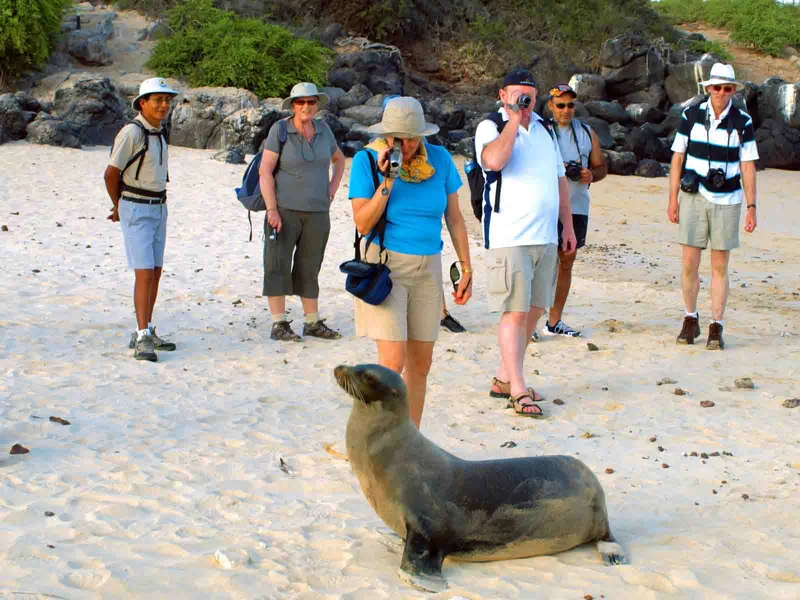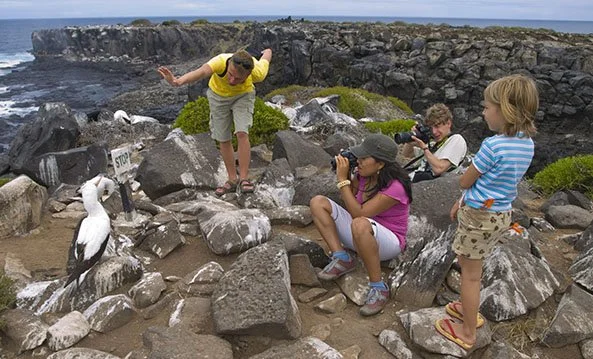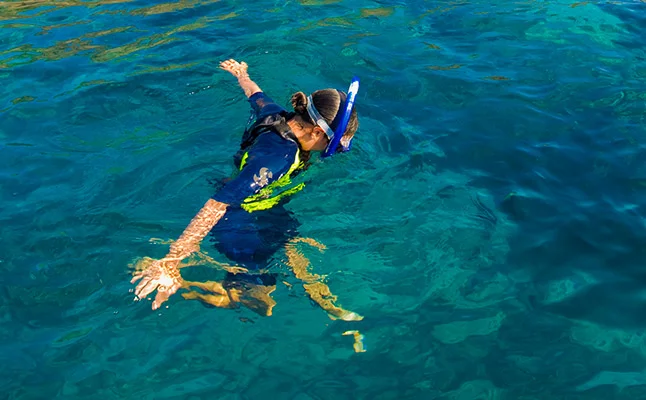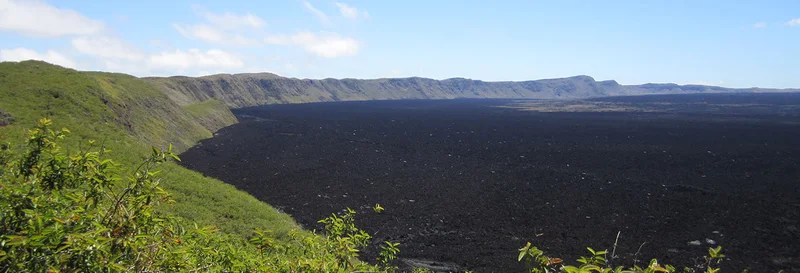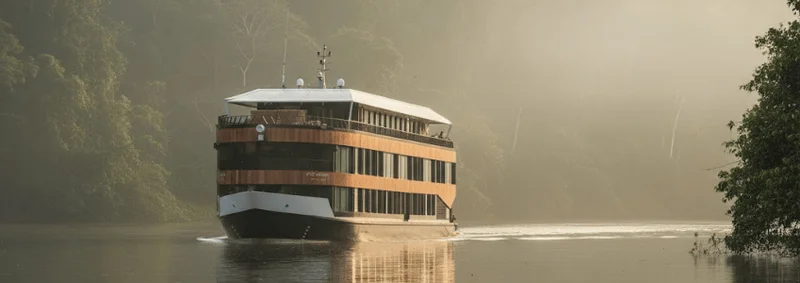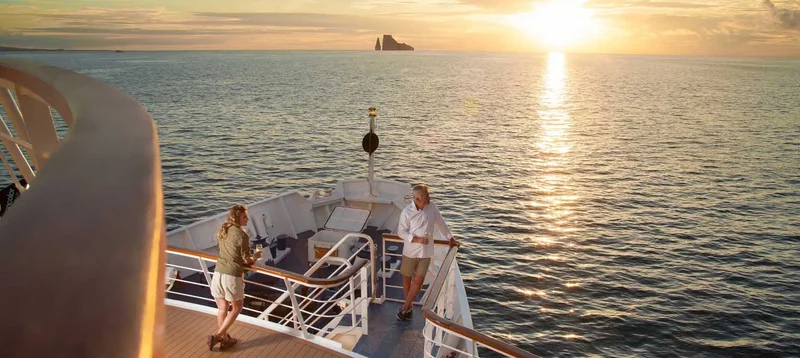
Discover the magic of the enchanted isles by planning your Galapagos vacations with Voyagers Travel. Our adventure planners have vast experience creating comprehensive itineraries based on your preferences. A vacation to these islands opens the opportunity to experience a unique natural history journey either cruising on board an expedition cruise ship, catamaran or sailing yachts, or taking a land-based tour staying at nature lodges. We specialize in Luxury class travel to Ecuador's wildlife archipelago, yet we can accommodate to most any budget, our team offers personalized and swift responses so you can have your vacation program ready in a few days. We take care of the environment by focusing on sustainable and responsible tourism to maintain the natural and untamed beauty of every Galapagos Island.
Discover our Galapagos Islands Vacations
A Galapagos Islands vacation package will allow you to encounter the unique marine iguana, walk alongside a giant tortoise, befriend a playful sea lion and the peculiar Galapagos penguin among other endemic species on each volcanic island.
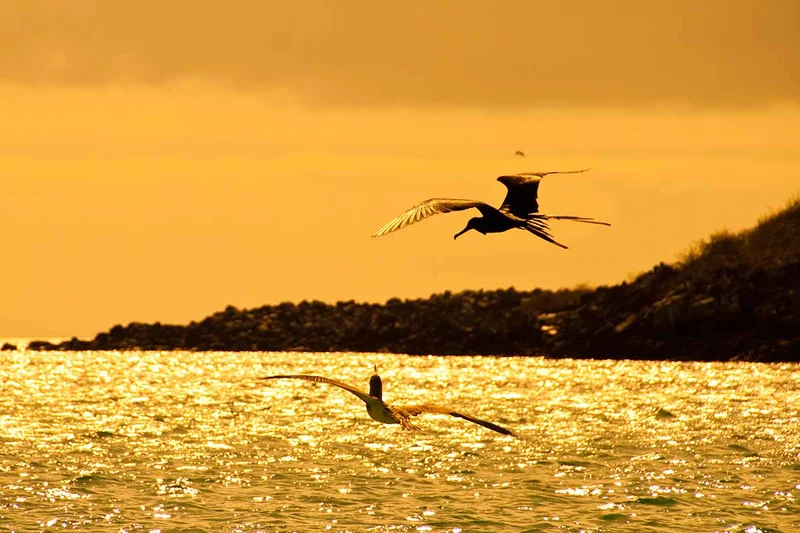
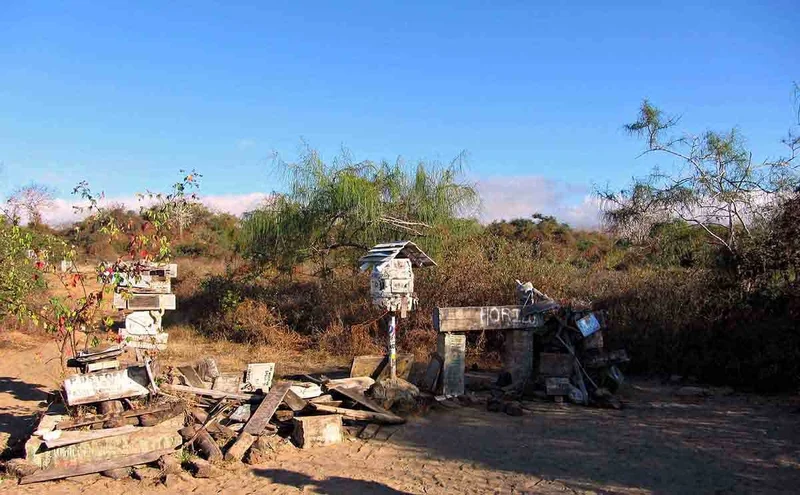
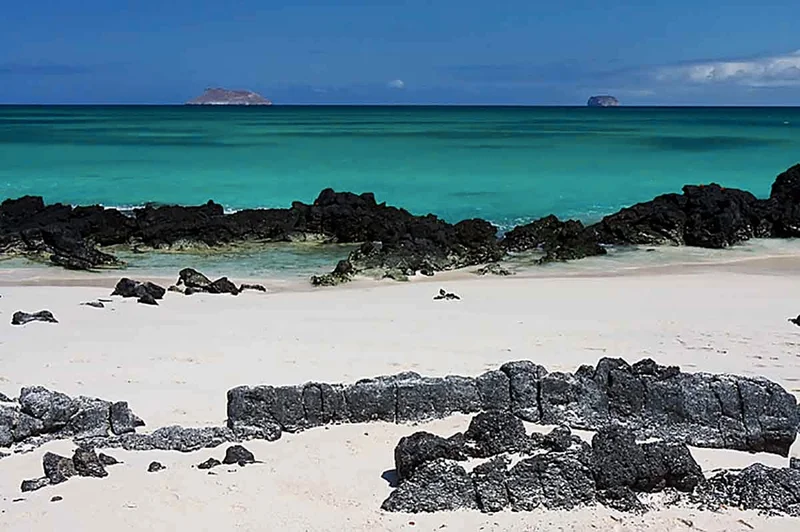

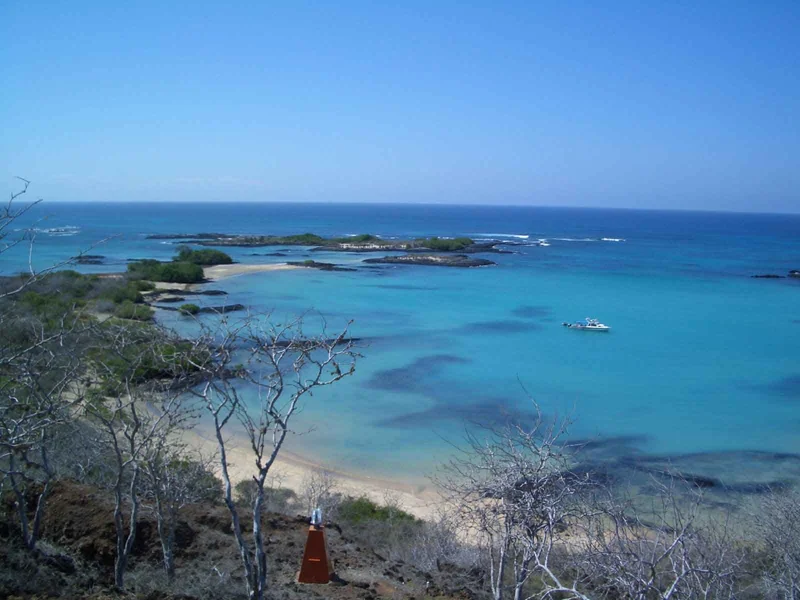

Unbeatable deals on Galapagos Cruises
If you finally found the time to visit Ecuador and the Enchanted Isles in the next weeks or maybe within the next couple of months, Voyagers Travel has the most amazing deals and last-minute offers for nature avid travelers. Enjoy your Galapagos tour traveling by boat and enjoy the most amazing and life-rewarding experience on board a magnificent small ship program with exceptionally affordable rates and add-ons included; here are some special deals for you to live a memorable Galapagos vacations
Charter a Yatch around the Galapagos Islands
Do you want the perfect Galapagos cruise with your Family or Friends? Then you should consider chartering your own yacht! The benefits of chartering a wonderful boat journey are many, including personalized attention throughout the trip, complete yacht’s areas at your disposal, special group rates, services according to the group’s needs and special add-ons to complement the experience!

Galapagos Luxury Vacations Packages
A Galapagos Islands cruise is the ideal way to fulfill your natural history expedition with high touch service on board, they have everything you can imagine to make your journey a comfortable, enjoyable and overall relaxing experience; choose between small 16-guests yachts/catamarans or large 48-100 guests Vessels for your Island getaway.
Enjoy exclusive amenities on board, cabins with panoramic views or private balconies, delightful Ecuadorian and international cuisine, stylish ample social areas and amazing open-decks with Jacuzzi, the ideal spot to observe the frigate birds or a Galapagos hawk flying above. For a more intimate experience while traveling in these islands, we recommended a yacht or catamaran; large expedition vessels offer larger areas that may be ideal for families traveling with children.
.jpg?alt=media&token=1933a69a-9958-4c58-965c-1296add5d561)
Galapagos Cruises Categories
Land Based Vs Liveaboard Vacations
Although traveling the enchanted archipelago on board an Expedition Cruise is the most efficient and extensive manner to enjoy the wildlife marvels during your Galapagos vacations. Land-based tour programs or “Island Hopping” tours have become a popular alternative in the past few years; especially for travelers that do not wish to take sailing trips for a variety of reasons, among them the effect of sea-sickness on board and the fact that boat vacations are a bit pricy in comparison to a hotel based-tour.

When cruising the islands, you have the opportunity to visit a larger variety of sites, mostly on uninhabited Islands where untamed wildlife prevails and the fact that you have two excursions, one in the morning and one in the afternoon, then overnight at your boat. On the other hand, Land-Tours offer the possibility to explore the best visitor sites on populated Islands: Santa Cruz, San Cristobal and Isabela plus day-visits to nearby Islands like Bartolome, Plazas, North Seymour with overnight stay at wonderful hotels and nature lodges on different categories and daily speed-boat rides to the sites with professional bilingual guides; land-based tours are also a great way to enjoy occasional diving day-tours.

Options for boat vacations and island hopping tours are quite abundant, the decision depends on your specific preferences, budget, time for tour and physical condition; Voyagers Travel can surely guide you on how to decide which option is best for you to enjoy a fascinating expedition trip.
Galapagos Diving Vacations
Diving cruises or live-aboard expeditions are a magnificent experience for the eager divers. The best way to explore the underwater world on your Galapagos vacation; the boats are fully dedicated to complete diving experience on the very best sites and locations within the Marine Reserve, including two top-diving sites in the World, Darwin & Wolf Islands on an 8-days program. These small yachts have itineraries that offer the best diving experience, but they are crafted specifically for experienced open-water divers.
However, being a diverse destination as only the Galápagos can be, if you are a PADI certified diver but do not have great experience, there is also the possibility to hire daily-diving tours from the populated Islands to wonderful locations like Kicker Rock, Academy Bay, Gordon Rocks and more!
Our top full-diving recommended yachts for a Galapagos dive vacation are:
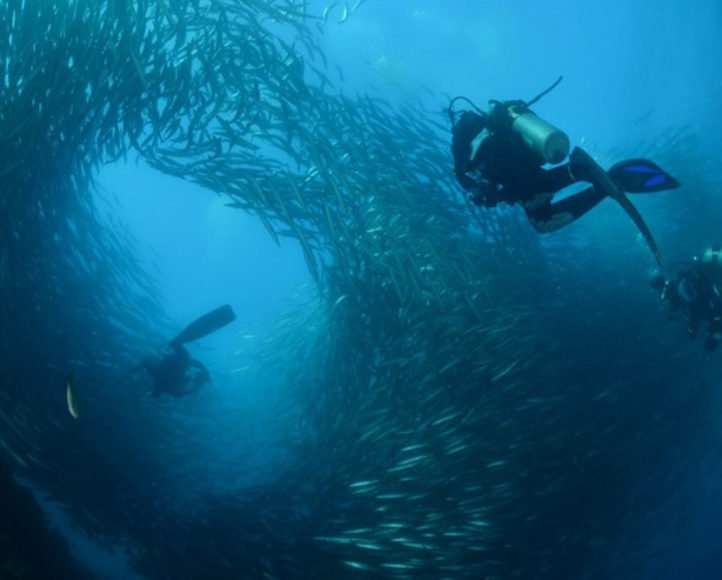

What are the Galapagos Islands ?
The Galapagos Islands are a volcanic archipelago located in the Pacific ocean 600 miles (1000 kms) off the coast of Ecuador in the northern trip of South America. This island cluster is made of 13 main islands, about 9 minor islands, 39 islets and some 600 ocean rocks is home to a strange and fascinating collection of creatures, many of which cannot be found anywhere else on earth. A marvel in terms of geology, about 3-5 million years ago, a huge volcanic eruption shook the earth breaking its crust creating and under sea mountain range. The molten lava formed a chain of islands, most of them the peak of an underwater volcano, which remained untouched for millions of years. A diverse array of animals and plants found their way there – and thrived. It’s hard to believe that such a harsh jumble of saltwater soaked lava fields has become so rich with life.
The Galapagos was where Charles Darwin came up with his theory of evolution in 1835, (which he presented in “The Origin of Species”) when he realised that it was possible to tell which island a finch came from based on the shape of its beak. When you explore these islands, it’s easy to see why Darwin was so inspired by the natural wonders he found here. The best way to explore these unique islands is on a yacht cruise.
The enchanted islands are a dream destination for any adventurous traveler and ideal for family trips as it allow visitors to explore and discover the unique natural marvels and untamed wildlife of this inimitable paradise of Earth. The information found on this site will surely guide you to choose the right trip to enjoy a memorable voyage.
A Guide to the Galapagos Islands
Uncertain on when is the best time to visit the Archipelago? Don’t really know what to expect from your trip or the activities to enjoy while exploring Galapagos? We have created a specialized Galapagos Vacation Guide to provide you with first-hand insider information and tips that will help you plan your trip; this is complemented with our personalized assistance that we provide our valued customers. If your looking for a Galapagos Cruise we can help by presenting a selection of boats or show you our choice of hotels for Galapagos Land Based Tours.
Why book with Voyagers Travel?
More information
The best complimentary information and interesting facts about the Galapagos archipelago: its history, its geology and the efforts made by the Ecuadorian authorities and international Institutions to preserve this natural paradise based on sustainability and responsible tourism and resources’ management.
Frequently Asked Questions
What's the best time to visit?
There’s no bad time to visit the islands. They are beautiful throughout the year and there is always something interesting happening. There are few migratory species and no need for the animals to wander off in search of food, so you can see the full cast of creatures all year long. The only difference throughout the seasons is their behaviours – so consider whether you want to visit to watch the spectacle of a particular mating season (or see newly born babies!).
In December and January you’ll be able to see the giant tortoise eggs hatching, in February you can watch the penguins migrating to Isabela and Fernandina from Bartolome and in March you can see the marine iguanas making their nests on North Seymour. May is blue footed booby mating season, so you’ll be able to watch their unique courtship dance.
If you are interested in humpback whales, June is the best month to spot them. July and August are ideal for sea lion watching, as this is when they will be breeding and giving birth. If you visit during September and October you’ll have a chance to spot adorable sea lion pups and blue footed booby chicks – and in November you can see whale sharks in the North West.
When it comes to weather, the warmer season from December to June is ideal, as you’ll have sunnier days, calmer seas and better underwater visibility. The June to November season sees the islands transform from green, lush tropical lands to a more barren, desert-like climate.
How to get there?
- Book an international flight to either Guayaquil or Quito (the capital of Ecuador). You’ll arrive at Jose Joaquin de Olmedo International Airport in Guayaquil or Mariscal Sucre International Airport in UIO.
- There are multiple flights per day to the Galapagos Islands from either of these two cities. (Quito is a larger and more interesting city to visit, with more choice for hotels and dining.)
- On the Galapagos Islands, there are two major airports you can arrive at: Baltra Island or in Puerto Baquerizo Moreno on San Cristobal Island.
- From there, you can take a local taxi or a ferry to the starting point of your cruise. (Some cruises will also offer an airport pickup service.)
Why visit the Galapagos Islands?
The Galapagos Islands are a one of a kind destination that has fascinated adventurous wildlife lovers for many generations. There are many reasons to visit, including:
- This archipelago is one of the most biodiverse places on the planet. It’s located on the confluence of three nutrient-rich ocean currents, creating ideal conditions for many animals to thrive.
- The islands are the only place you can see many strange and rare creatures, such as the Galapagos Penguin, the Galapagos Marine Iguana and the world’s only nesting site of the Waved Albatross.
- There are more than 400 species of fish surrounding the islands, making it a scuba diving and snorkeling paradise.
- 97% of the islands have been declared a national park.
- You can spot the iconic giant tortoise, which can live up to 150 years and weigh 595 pounds. It’s the only place in the northern hemisphere where you can see penguins in their natural habitat.
- The Galapagos is an archipelago made up of 17 different islands, each with its own unique landscape and collection of wildlife. It’s also known for the Charles Darwin Research Station, home to the famous giant tortoise breeding programme.
Wildlife viewing is the main reason to travel to the Galapagos Islands. There’s no other place on earth where you can see so many unique creatures in such a beautiful, unspoiled setting. The experience of swimming with sea lions, walking amongst giant tortoises and seeing baby penguins waddle across the beach is unforgettable.
It is possible to come to the islands and not venture out to see the wildlife – and some visitors do. They stay mainly in highly developed Santa Cruz Island, do a bit of surfing, enjoy the nightlife in Puerto Ayora, visit the local beaches and don’t go much further.
However, we feel that in order to get a true Galapagos experience, you need to venture beyond the main island to see the pristine landscapes and diverse wildlife these islands are famous for. Otherwise, why not just stay in any beachside town in Ecuador? The archipelago is unlike any other destination in the world – and it’s really all about the wildlife. Check out our full Galapagos vacation planner.
What are the advantages of a Galapagos Islands cruise?
Why take a cruise trip in the Galapagos Islands, rather than staying in hotels and going on day trip excursions? Here are some of the main benefits that yacht charter experiences can offer.
It’s Easier to Plan
When you book a Galapagos Islands Cruise, all of your tours and excursions are included on the tour – which makes it a lot easier to plan and book your dream getaway. You don’t have to worry about lining up all of your land excursions and arranging your hotel bookings.
You can simply make one booking that will include all of your experiences. With the help of an expert travel concierge, you can even design a unique itinerary that caters to your particular interests.
You’ll Make the Most of Your Time
If you try to see the Galapagos islands on a land based trip, you’ll spend a lot of time getting from your hotel, onto a day-trip boat, out to the day’s destination, then sailing back to your hotel.
When you take a cruise, the boat will move from place to place during the night. This means that you’ll be able to sleep through all of that time-consuming travel time and wake up at a new destination ready for a full day of exciting adventures.
You’ll Get Exclusive Access
Land-based excursions are limited to only the five islands that can be reached in one day. When you visit on a boat, you’ll be able to visit the more remote and distant islands that can only be reached via overnight boat.
This means that you’ll be able to see a more pristine and unspoiled side of the Galapagos wilderness – far from any human development.
Visitor Limits Keep The Experience Unspoiled
In the Galapagos, there are limits on how many people can visit the islands – in order to keep these natural wonders as pristine as possible. There are only a certain number of boats allowed to offer cruises and in order to add a new boat to the fleet, an older one must be removed.
This means that when you cruise the remote islands of the Galapagos via boat, you won’t have to worry about crowds and you’ll be seeing beautiful, unspoiled locations that are quiet and pristine.
What to expext on aboard the boat?
Most live-aboard cruise experiences in the Galapagos offer 4-8 day itineraries, with set route and departure dates. This is because the routes are dictated by the Galapagos National Park officials in order to control the number of visitors and reduce environmental stress.
Galapagos boats are limited to a maximum of 100 passenger, but many boats carry much fewer than that. While larger boats have more services on board such as lectures and medical facilities, the smaller boats offer a more intimate experience.
Comfort Level
Onboard a luxury ship you’ll usually have a larger cabin, sometimes with your own private balcony. The cabins are usually en suite and are compact in their design so that they can maximise living space. However, even on the smallest of vessels you’ll usually find a sun deck where you can stretch out and relax and watch wildlife, as well as a dining area and lounge.
Food
What will the food be like on your Galapagos cruise? It depends on the boat you book your tour on, but you can rest assured that on a luxury cruise you will be fed well. (Keep in mind, the smaller and more high end the boat, the better the food – as the head chef will be cooking for 16 guests rather than 100)
Since you’ll be in one of the richest marine ecosystems in the world, you can rest assured that the seafood and fish will be wonderfully fresh and tasty. One of the most famous dishes is ceviche, made with lobster, shrimp, fish, squid or octopus marinated in a tangy, citrus brine.
Many of the dishes on board will be inspired by traditional Ecuadorian cuisine – which features rice, Andean potatoes and meat. Of course, there’s also the delicious tropical fruit. You can expect to feast on guanabana, naranjilla and other yummy local produce.
Plus, nearly every Ecuadorian-style meal you will have on the Galapagos Islands will come with plantain – a fruit similar to banana that is served fried, mashed or made into chips.
Fitness Level
If you are content with viewing wildlife from the deck of the boat and not venturing much further than that, then a Galapagos trip could suit travelers of any fitness level. However, in order to truly get the most out of a visit to this unique island archipelago you’ll need to be able to hike to the more remote spots. Many of the hikes involve walking up volcanoes and hiking uphill in the dry heat.
Plus, you’ll also need to be physically prepared to swim and snorkel in the Pacific Ocean. After all, it would be a shame to miss the chance to see turtles and penguins close up. So, it is recommended that you have at least a moderate level of fitness in order to enjoy this trip to the fullest.
Safety
Flying through mainland Ecuador to reach the Galapagos Islands is very safe. According to the State Department, there are no travel warnings for Ecuador and the only advice is to “exercise normal precautions.” The Galapagos Islands are even safer than the mainland – so as long as you’re aware of your surroundings and you listen to any safety advice from your tour guide, you’ll be fine. (For example, be cautious around certain types of wildlife such as sharks and male sea lions.)
One of the major safety risks you’ll need to worry about when you are on a Galapagos tour is sunburn and heatstroke. Because you will be very close to the equator, the sun’s rays will be stronger and you’ll need to take extra care to protect yourself. Even if the air feels cool, the sun can still be quite strong. Bring along coral-reef friendly sunscreen, a hat with a brim and a skin to wear during snorkeling excursions.
Also, take care when swimming in the Pacific Ocean – as there can be many hidden currents and riptides. Your guide will advise you on where you can safely swim.
In case of an emergency, the boat is equipped with first aid supplies, a satellite phone, life vests for all passengers and emergency flares. The boats are all regularly checked to ensure that they are safe for passengers.
Health
If you suffer from seasickness, book a cruise on a larger boat as it will experience less movement. You can also bring along seasickness medication. On most boats there are emergency medical services on board and on the larger boats there might even be a pharmacy. It also helps to sit out on the open deck where you can breathe the fresh air and see the horizon.
Ecuador does not require visitors to have any specific vaccinations. However, the Center for Disease Control and Prevention recommends that you are vaccinated for typhoid and hepatitis A. Malaria and rabies precautions are recommended by the CDC as well, but check with your doctor before you travel.
If you are taking any form of medication, make sure that you have your prescribed supply for the duration of your trip – as you can’t guarantee that you’ll be able to find your specific drug in one of the pharmacies on the islands.
Guides
All ships in the Galapagos have to bring a certified naturalist with them. The Galapagos National Park provides training and strictly regulates the guides who are allowed to work on the islands. The guide course is very long and detailed, which ensures that all guides are well-educated. Usually, the more luxurious the ship the more experienced and professional the guide will be.
However, you can’t necessarily assume that all guides will speak English – so it’s something to check before booking a tour. The main duty of your guide will be to accompany you on all land excursions and tell you about the animals, plants, geology and history of each of the islands you visit.
What activities will I do on a Galapagos Islands cruises?
These are the types of activities and excursions you might expect on a typical Galapagos islands yacht cruise.
Volcano Hikes
Hiking through the surreal and beautiful volcanic landscape of the Galapagos is a great way to see the natural beauty of the Galapagos Islands up close.
Take a hike around the rim of the Volcán Sierra Negra, the second largest active caldera on earth and the only one volcano on the islands that visitors are allowed to hike. The trail has a gradual incline, so it is manageable for those with moderate fitness (although you should bring plenty of water as the equatorial sun can be strong.)
The 9 km wide, 91 metre deep crater is a truly spectacular site, especially with the views of the ocean in the distance. Be sure to bring an expert guide with you on this 5 hour hike, so that they can tell you about the flora and fauna as well as the history of the landscape.
Snorkelling
Another one of the most popular Galapagos activities is snorkeling. Peer beneath the surface of the water to see the incredibly diverse marine of the Galapagos. You might even spot turtles, hammerhead sharks, golden rays and parrotfish.
Some of the best snorkeling spots in the Galapagos include North Seymour Island, James Bay on Santiago Island and Punta Vicente Roca on Isabela Island. Your yacht charter cruise will provide you with flippers, a mask and a snorkel – but you can also bring your own if you have them.
The great thing about snorkeling is that you don’t have to have any special training. Anyone can do it – as long as you know how to swim. At the beginning of your cruise trip, you’ll receive a snorkeling orientation from your guide – who will teach you what to look out for and how to avoid damaging the delicate coral.
Scuba Diving
The Galapagos Islands are considered one of the best scuba diving destinations in the world. There is excellent diving throughout the year, but June-December is exceptional – as this is when hammerheads, whales, rays and other large marine creatures come out to play. Some of the best diving destinations are Wolf and Darwin Islands – which can only be visited by boat.
Typically, diving in the Galapagos is for more advanced divers who feel comfortable in deep cold water with potential for strong currents and low visibility. So, make sure that you have the appropriate training and experience level before attempting to scuba dive in the Galapagos.
Sea Kayaking
With thousands of miles of rocky shorelines and secluded coves, the Galapagos Islands is ideal for exploring via kayak. Kayaking is a great activity during your Galapagos cruise, as it allows you to get up close with the wildlife and see remote spots that cannot be reached any other way.
Of course, the Galapagos National Park Service carefully regulates sea kayaking in the marine reserve, so you’ll need to make sure you have booked your tour with a company that has been granted special kayaking permissions within the park.






